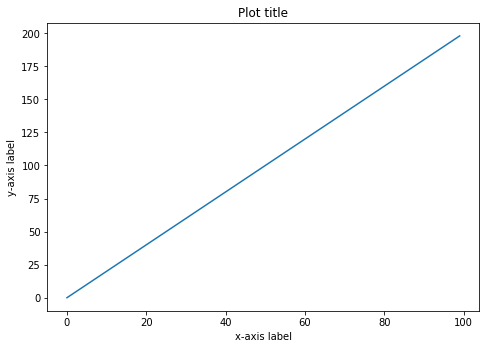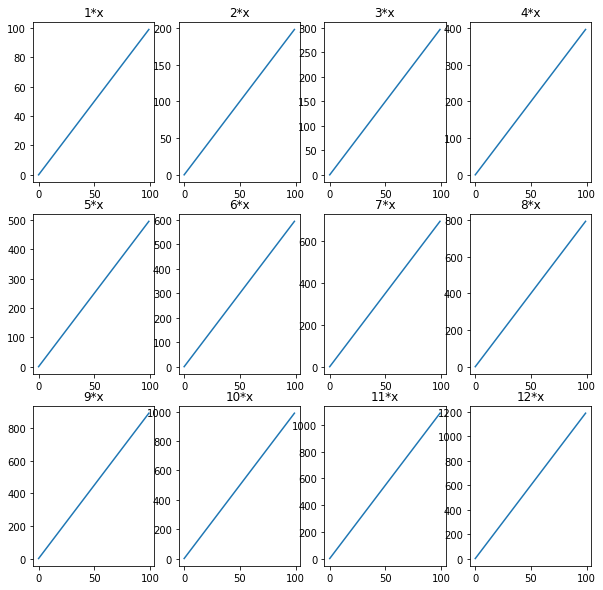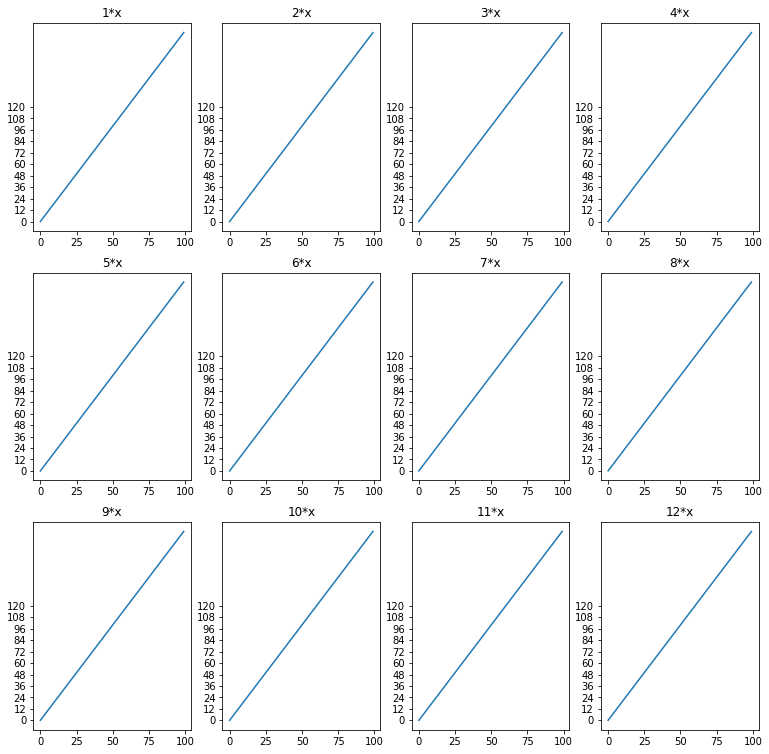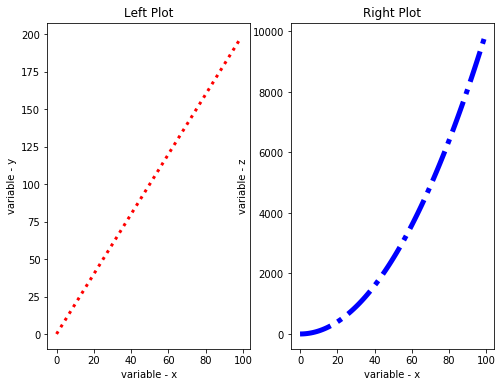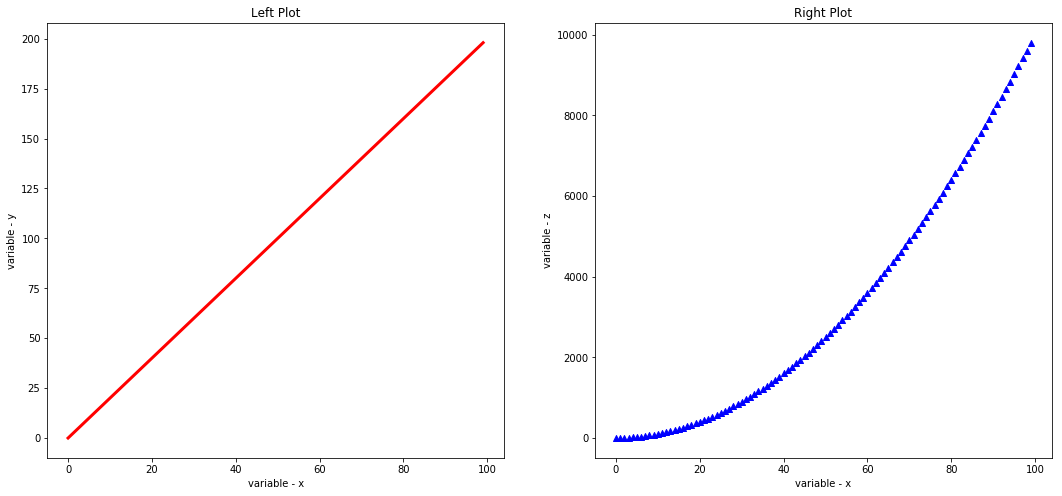This lab requires you to draw some basic visualizations using the techniques from the previous lesson.
You will be able to:
- Create subplots using a Matplotlib figure
- Use different linestyles within a Matplotlib visualization
- Create labels and titles for visualizations
- Create a lineplot using linspace
Let's give you a head start by generating some data for you to plot:
import numpy as np
# Generate a list of numbers from 0 to 99
x = np.arange(0,100)
# Multiply values of x with 2 to get y
y = x*2
# Calculate square of values in for variable z
z = x**2
# Print x, y and z
print (x, y, z)[ 0 1 2 3 4 5 6 7 8 9 10 11 12 13 14 15 16 17 18 19 20 21 22 23
24 25 26 27 28 29 30 31 32 33 34 35 36 37 38 39 40 41 42 43 44 45 46 47
48 49 50 51 52 53 54 55 56 57 58 59 60 61 62 63 64 65 66 67 68 69 70 71
72 73 74 75 76 77 78 79 80 81 82 83 84 85 86 87 88 89 90 91 92 93 94 95
96 97 98 99] [ 0 2 4 6 8 10 12 14 16 18 20 22 24 26 28 30 32 34
36 38 40 42 44 46 48 50 52 54 56 58 60 62 64 66 68 70
72 74 76 78 80 82 84 86 88 90 92 94 96 98 100 102 104 106
108 110 112 114 116 118 120 122 124 126 128 130 132 134 136 138 140 142
144 146 148 150 152 154 156 158 160 162 164 166 168 170 172 174 176 178
180 182 184 186 188 190 192 194 196 198] [ 0 1 4 9 16 25 36 49 64 81 100 121 144 169
196 225 256 289 324 361 400 441 484 529 576 625 676 729
784 841 900 961 1024 1089 1156 1225 1296 1369 1444 1521 1600 1681
1764 1849 1936 2025 2116 2209 2304 2401 2500 2601 2704 2809 2916 3025
3136 3249 3364 3481 3600 3721 3844 3969 4096 4225 4356 4489 4624 4761
4900 5041 5184 5329 5476 5625 5776 5929 6084 6241 6400 6561 6724 6889
7056 7225 7396 7569 7744 7921 8100 8281 8464 8649 8836 9025 9216 9409
9604 9801]
Import matplotlib.pyplot as plt and set %matplotlib inline for generating inline images in jupyter notebooks.
# import matplotlib.pyplot and set inline plotting Now that we have our data all set and matplotlib in our python environment, we can try some basic plotting techniques.
Perform the following steps in the cell below:
- Create a new figure object
figusing.figure()function. - Use
add_axes()to add an axisaxto the canvas at absolute location [0,0,1,1]. - Plot (x,y) on that axes and set the labels and title.
This was easy, let's move on to drawing multiple plots within a figure space.
Perform following actions:
- Create a subplots figure with 3 rows and 4 columns
- Plot the lines
$y=x$ ,$y=2x$ ,$y=3x$ ,$y=4x$ ,...$y=10x$,$y=11x$ ,$y=12x$ in the respective subplots over the domain [0,10].
Repeat the above exercise, but standardize the axes of all of your subplots so that you can more easily compare the slopes of the lines. You might need to make your figure bigger to keep the y-axis labels legible.
Perform following steps in the cell below:
- Create a figure of size 8x6 inches
- Add two axes to the figure by dividing it in 1 row and 2 columns with the
add_subplotmethod - Plot (x,y) and (x,z) on the ax1 and ax2 respectively.
- Set the line width of first axes to 3, line style as dotted and color it red.
- Set the line width of second axes to 5, line style as dash-dot (-.) and color it blue.
- Give the plots some labels and titles
Above figure looks fine but a bit out of proportion. Let's resize this to make the plots look more appealing by ensuring that subplots are square in shape. Also change the line style of first plot (left) and change the type of 2nd plot (right) to a scatter plot with a ^ marker style.
Congratulations! You've now learned the basics of plotting, labeling and customizing plot with matplotlib. The following lessons will focus on employing these techniques to plot multiple data types in different contexts.
This lab focused on ensuring that you understand the basics plotting techniques in matplotlib using plotting objects and functions to draw single plots, multiple/subplots using absolute and relative plotting. You also learned how to customize the plots with labels, titles and axes definitions.
